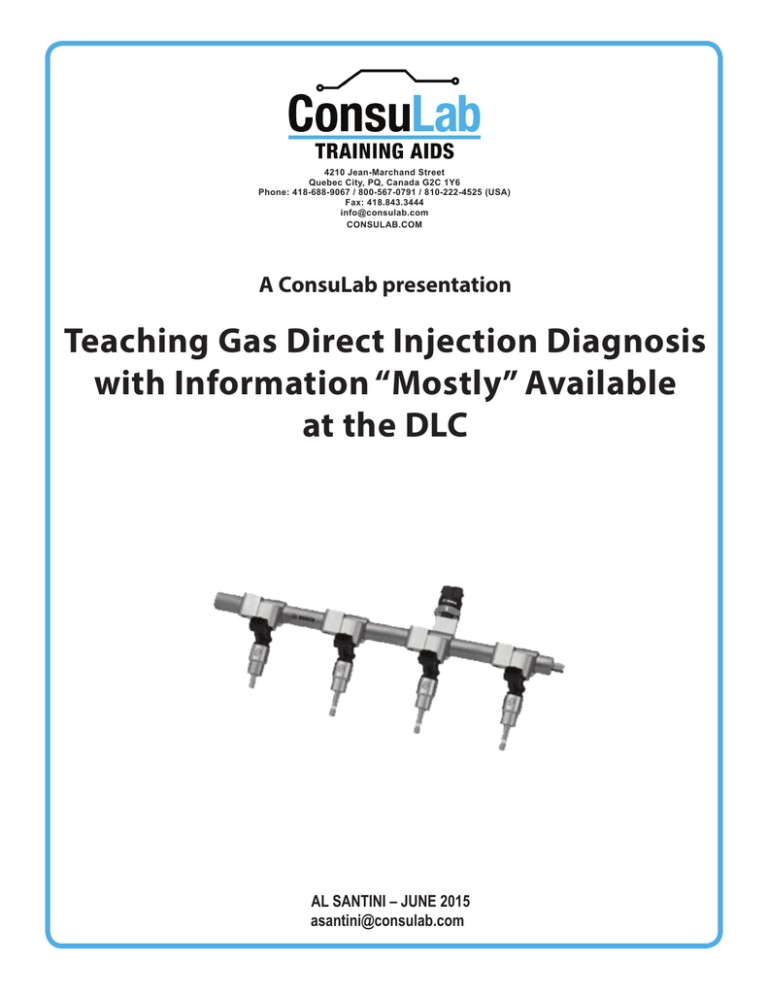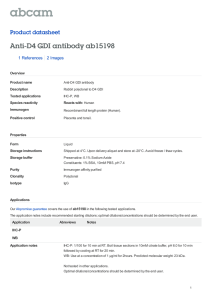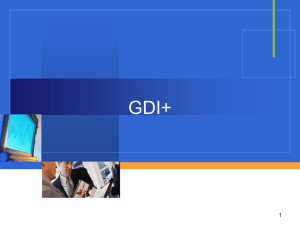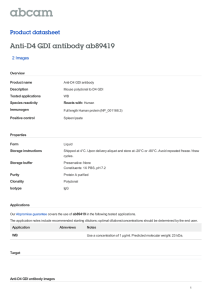Teaching Gas Direct Injection Diagnosis with Information “Mostly
advertisement

4210 Jean-Marchand Street Quebec City, PQ, Canada G2C 1Y6 Phone: 418-688-9067 / 800-567-0791 / 810-222-4525 (USA) Fax: 418.843.3444 info@consulab.com CONSULAB.COM A ConsuLab presentation Teaching Gas Direct Injection Diagnosis with Information “Mostly” Available at the DLC AL SANTINI – JUNE 2015 asantini@consulab.com TEACHING GDI DIAGNOSIS This handout is intended to follow the presentation titled the same. We will look at: • Review the basics of GDI • Look at the safety issue with students • Examine data available at the DLC using a computerized scanner (auto EnginuityTM) • Use the graph function for various sensors • Using a breakout box to capture additional patterns With this information and the accompanying PowerPointTM series (available at consulab.com – resources), you can safely teach the basics of diagnosis of a GDI system. Many of the patterns come off of the ConsuLab GDI Bench which uses a Hyundai engine fully operational with attached breakout box. This trainer will allow capturing all relevant patterns that are inaccessible in a normal vehicle. EM-140 G4FD 2012 Hyundai Accent GDI 1.6L Why teach diagnosis mostly at the DLC? • Keeps students away from potentially dangerous pressures • Allows the data to be viewed on a large screen (usually) • As systems have become more complicated, testing individual components has become more difficult or totally impossible • Disconnecting a component for testing opens up the “school syndrome” (damaged connections from multiple probing by many students) • Using modern scanners opens up a tremendous amount of data for analysis. Analysis equals understanding • “Most” technicians will utilize a scanner as their preferred tool of choice The Basics – GDI (Gas Direct Injection) utilize a low pressure side and a high pressure side. consulab.com 2 TEACHING GDI DIAGNOSIS The low pressure side consists of the fuel tank with sending unit and low pressure pump. The high pressure side starts at the high pressure pump and runs through the lines to the injectors. Frequently the high pressure side is inaccessible since it may be under the intake manifold. Always stress safety with the fuel system. The system pressures are frequently thousands of lbs and that much pressure can easily cause medical issues or death. Fuel entered the index finger and flowed through the skin up to the wrist. Without immediate attention this would have resulted in the loss of a hand or possibly sufficient contamination to have caused death. Do not under any circumstances allow students to open up a high pressure system without YOU being by their side. GDI offers complete control of fuel by injecting fuel directly into the combustion chamber. consulab.com 3 TEACHING GDI DIAGNOSIS A high pressure pump is generally driven by a drive lobe located on the camshaft. This pump gives a GDI system the distinctive noise. The pump is the reason why most GDI engines require synthetic oil. The pressure on the cam is tremendous at high fuel pressure outputs and can easily be destroyed if the incorrect oil is used. The low pressure pump supplies fuel to the high pressure pump at what were normal pressures for a port fuel injected engine. This scan shows the pressure at idle for a GM product. This low side pressure will not vary under normal conditions and is sometimes controlled by a pressure regulator or by pulse width modulating the fuel pump. . consulab.com 4 TEACHING GDI DIAGNOSIS The high pressure pump is cam driven with a bucket, roller or a follower. It is capable of pressures in excess of 3000 psi. It generally has an internal pressure relief and defaults to a specified pressure (either high or low) when it is unplugged. Note: Do not allow students to unplug the pressure relief as the pressures can be extreme and dangerous. Here is an Auto EnginuityTM scan of a high pressure system at idle. Note that it is over 600 psi with no load. This pressure is regulated by pulse width modulating the pump. At idle it will look like the following. Note this is the pattern off of the ConsuLab GDI Hyundai bench. The pressure was 573 psi. consulab.com 5 TEACHING GDI DIAGNOSIS If we raise the speed up to approximately 2500 rpm, the pulse width will increase with much less space between pulses. This allows the pump to build up the pressure. This pattern was taken off of the ConsuLab GDI bench. The running pressure was around 1700 psi. consulab.com 6 TEACHING GDI DIAGNOSIS Notice that the number of pulses in each group increases. The GDI bench was running at almost 1700 psi without a load. Fuel Trim used to be used for: • Adjusting fuel injector pulse width. Not uncommon to have a 3 times increase in pulse width idle to 2500 rpm. • Injector pulse width changed by allowing fuel trim (short term or long term) to add or subtract to the fuel injection pulse width. Now with GDI engines there is very little fuel injector pulse width change. The change in fuel volume is still necessary but is now changed by varying the pressure at the injector. The result is the same: either vary the pressure or vary the on time of the injector. Fuel injector pulse width at idle: 0.99 – 1.07 mSec Here is the fuel injector pattern taken off of the breakout box on the GDI bench: consulab.com 7 TEACHING GDI DIAGNOSIS Fuel Injector pulse width at WOT under load: 1.02 – 1.13 mSec Here is the fuel injector pattern at 2500 rpm on the GDI bench: Very little change is seen and these scans and patterns have varying loads from idle to WOT in drive! The only real change is in the number of pulses of the fuel injector. At low speeds more pulses are added to mix the fuel more evenly. As the engine speeds up less pulses are needed since there is lots of turbulence in the cylinder to mix the fuel and air. How does the sensing of fuel occur on GDI engines? It depends on the type of system. If the vehicle is a ULEV (Ultra Low Emission Vehicle) there will usually be 2 standard oxygen sensors: one to run the engine and the second to look at catalytic converter operation. If the vehicle is a SULEV (Super Ultra Low Emission Vehicle) it will usually have a wide band sensor ahead of the converter and a standard O2S after the converter. The Hyundai engine on the GDI bench is a SULEV. consulab.com 8 TEACHING GDI DIAGNOSIS The front O2S’s (B1S1 and B2S1) can be scanned and graphed in a usual manner resulting in a pattern that shift above and below 450 mVolts with above indicating rich and below indicating lean. Notice that the two O2S’s follow one another. Their rich and lean voltages are the same. This vehicle is in fuel control, and is a GDI GM V6 with virtually no fuel trim. The vehicle is a ULEV. We have all taught oxygen sensors for many years but few of us have taught wide band sensors. They are different and may be confusing to some students. Teach that they are not voltage based like traditional O2S’s and that they generate a current signal. Some scanners will show this current signal with 0 mA being indicative of a stoichiometric air fuel. Additionally some manufactures generate a voltage signal within the PCM that may be displayed on a scanner. If either mA or 3.3 Volts shows as a scanner PID, the vehicle being tested has a wide band sensor. consulab.com 9 TEACHING GDI DIAGNOSIS The ConsuLab Hyundai GDI bench is a SULEV and therefor has a wide band sensor. The scanner shows: Notice that the B1S1 shows current at about 0 mA and an equivalence ratio of 0.98. An equivalence ratio of 1 is considered perfect or lambda (14.7:1 A/F ratio) On many vehicles the wide band sensors can be tested by injecting propane and watching the PID change. Remember that 0.00 mA is considered perfect for B1S1 If we add some propane to the mix or accelerate forcing the system rich the scanner now shows the response to the rich. Rich will be negative current, as shown. This sensor is extremely fast and ideally sits right around 0.00 mA normally. consulab.com 10 TEACHING GDI DIAGNOSIS SUMMARY Low pressure side feeds the High Pressure side of the system. High pressure is directly injected into the cylinder. The pressure is controlled to control the fuel volume injected. The pressure pump (high side) is pulse width modulated. Either a standard O2S (ULEV) or a wide band sensor (SULEV) is used to measure fuel control and adjust. Students can look at: • Low pressure on a graphing scanner and figure out how it is controlled - Pump speed - Sensing volume - Pressure control solenoid - PWM of pump Make sure they realize that if low pressure is down there might be some fuel trim and injector pulse width changes. High pressure under varying speeds and load. Pressure control solenoid. Pulse Width under varying conditions. Look at O2S. Look at Wide Band sensor. consulab.com 11 TEACHING GDI DIAGNOSIS ADDITIONAL CONSIDERATIONS Virtually all testing can be accomplished on the ConsuLab GDI Bench. A fault box can be added for testing your students. The breakout box, which is standard, allows for in class pattern analysis. Some patterns can be captured that are virtually impossible on a vehicle. Call ConsuLab or see consulab.com for more information. EM-140 2013 Ford Escape GDI 1.6L AL SANTINI – JUNE 2015 asantini@consulab.com consulab.com 12





